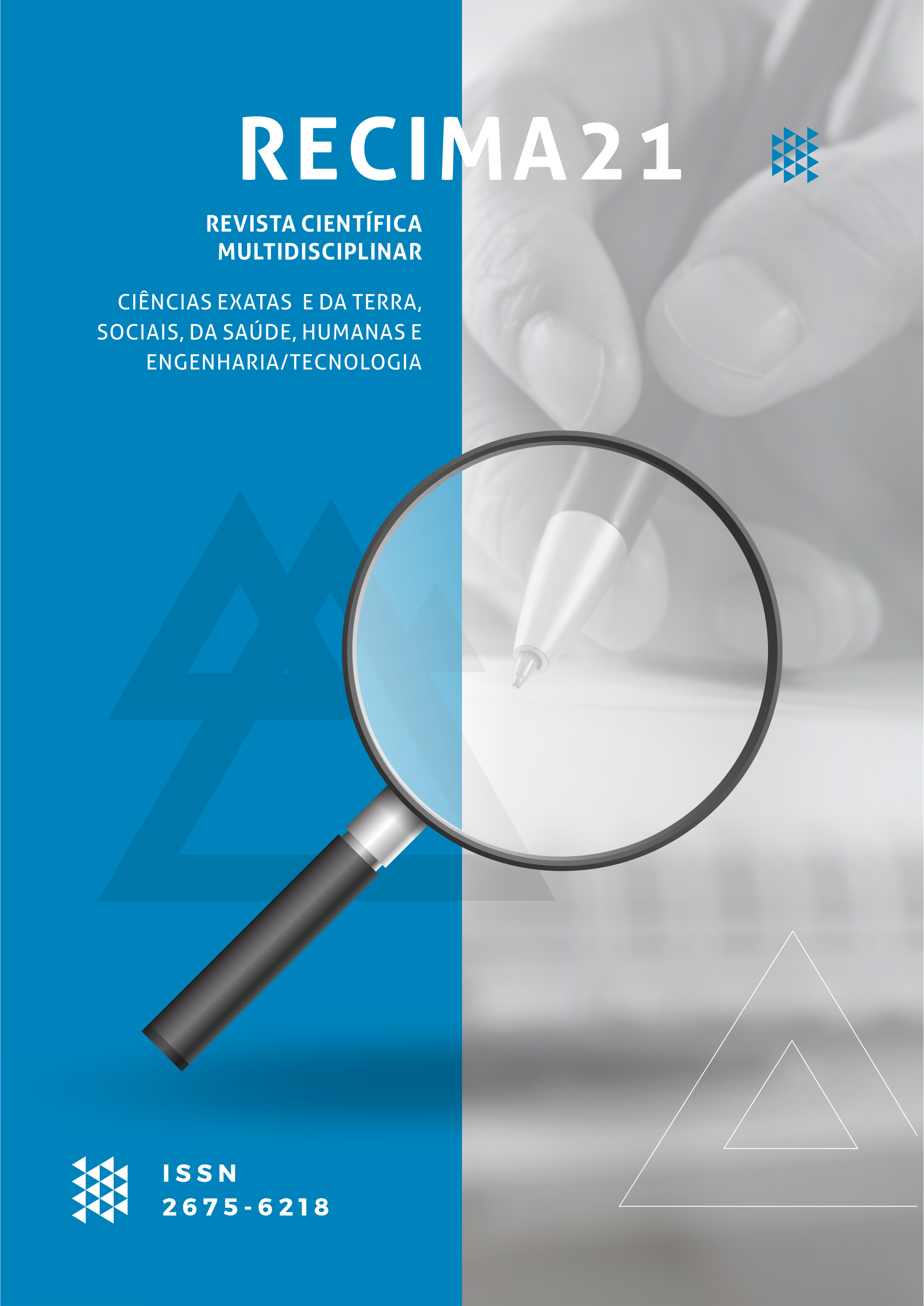POST-COVID-19 ANTIMICROBIAL RESISTANCE: LITERATURE REVIEW
DOI:
https://doi.org/10.47820/recima21.v3i3.1266Keywords:
COVID-19, Infections, ResistanceAbstract
The new coronavirus reaches the cells of the lower respiratory tract, starting an inflammatory process. Considering this infection, the immune system must eliminate the pathological agents and mantein cellular homeostasis, tissue repair and generation of immunity memory. When there is a failure in this pathway, this system encounters a series of difficulties for the resumption of balance, in addition to secondary infections, leading to additional clinical complications. Thus, this study sought to address the immune response to Sars-CoV-2, and the main post-Covid secondary infections (bacterial and fungal) and antimicrobial resistance in this context. This is a literature review based on the analysis of journals from the following academic platforms: Google Scholar, Center for Biotechnology Information (PubMed), Science Direct, Scientific Electronic Library Online (SciELO) and Scopus. The research was delimited in a range from 2003 to 2021, using the keywords COVID-19 as a search tool; Immune response; Bacterial infections; Fungal infections; Resistance. The results obtained in the studies demonstrate the impact of secondary infections on mortality, thus, among the main infections, bacterial infections (84%) stand out, including mainly the agents: Staphylococcus aureus, Streptococcus pneumoniae, Clostridioides difficile and Mycoplasma pneumoniae. As for secondary fungal infections, Aspergillus sp. and Candida affected mainly critically ill patients. Based on the data, an evident problem was the difficulty in identifying the agent causing the secondary infection, resulting in a scenario of intense use of broad-spectrum antibiotics, contributing to the selection of resistant pathogens and, controversially, the worsening of the prognosis of the disease patient.
Downloads
References
Beadling, C., & Slifka, M. K. (2004). How do viral infections predispose patients to bacterial infections?. Current opinion in infectious diseases, 17(3), pp. 185–191.
Blanco-Melo, D., et al. (2020). Imbalanced Host Response to SARS-CoV-2 Drives Development of COVID-19. Cell, 181(5), pp. 1036–1045.e9.
Brasil. Agência Brasil. Empresa Brasil de Comunicação (ed.). (2020). Organização Mundial da Saúde declara pandemia de coronavírus: atualmente, ao menos 115 países têm casos da doença. Df, 2020. Color. Disponível em: https://agenciabrasil.ebc.com.br/geral/noticia/2020-03/organizacao-mundial-da-saude-declara-pandemia-de-coronavirus. Acesso em: 19 jul. 2021.
Broggi, A., et al. (2020). Type III interferons disrupt the lung epithelial barrier upon viral recognition. Science (New York, N.Y.), 369(6504), pp. 706–712.
Caglar, K., et al. (2011). Investigation of interleukin-10, tumor necrosis factor-alpha and interferon-gamma expression in experimental model of pulmonary aspergillosis. Mikrobiyol Bul, 45(2), pp. 344-352.
Cai, S., Sun, W., Li, M. & Dong, L. (2020). A complex COVID-19 case with rheumatoid arthritis treated with tocilizumab. Clin Rheumatol 39, pp. 2797–2802.
Camargo, J. F., et al. (2015). Impaired T Cell Responsiveness to Interleukin-6 in Hematological Patients with Invasive Aspergillosis. PLOS ONE, p. e.0123171.
Chaudhry, B., et al. (2021). Post COVID-19 MSSA pneumonia. SAGE open medical case reports, 9, p. 2050313X211005996.
Contou, D., et al. (2020). Bacterial and viral co-infections in patients with severe SARS-CoV-2 pneumonia admitted to a French ICU. Annals of intensive care, 10(1), pp. 1-9.
Cusumano, J. A., et al. (2020). Staphylococcus aureus bacteremia in patients infected with COVID-19: a case series. In: Open forum infectious diseases, 7(11), p. ofaa518.
Duployez, C., et al. (2020). Panton-Valentine Leukocidin-Secreting Staphylococcus aureus Pneumonia Complicating COVID-19. Emerging infectious diseases, 26(8), pp. 1939–1941.
Fan, B. E., Lim, K., Chong, V., Chan, S., Ong, K. H., & Kuperan, P. (2020). COVID-19 and mycoplasma pneumoniae coinfection. American journal of hematology, 95(6), pp. 723–724.
Galvão, M. H. R. & Roncalli, A. G. (2020). Factors associated with increased risk of death from covid-19: a survival analysis based on confirmed cases. Revista Brasileira de Epidemiologia, v. 23.
Garcia-Vidal, C., et al. (2021). Incidence of co-infections and superinfections in hospitalized patients with COVID-19: a retrospective cohort study. Clinical Microbiology and Infection, 27(1), pp. 83-88, 2021.
Gonçalves, A. H. (2011). MECANISMO DE AÇÃO E TOXICIDADE DA ANFOTERICINA B NO TRATAMENTO DE MICOSES. 2011. 29 f. Monografia - Curso de Especialização de Microbiologia, ICB Instituto de Ciências Biológicas da Universidade Federal de Minas Gerais - Ufmg., Belo Horizonte, 2011. Disponível em: https://repositorio.ufmg.br/handle/1843/BUOS-99WH86. Acesso em: 03 jul. 2021.
Granata, G., et al. (2020). The burden of Clostridioides difficile infection during the COVID-19 pandemic: a retrospective case-control study in Italian hospitals (CloVid). Journal of clinical medicine, 9(12), p. 3855.
Guo, Yan-Rong., et al. (2020). The origin, transmission and clinical therapies on coronavirus disease 2019 (COVID-19) outbreak–an update on the status. Military Medical Research, 7(1), pp. 1-10.
Habas, K., et al. (2020). Resolution of coronavirus disease 2019 (COVID-19). Expert review of anti-infective therapy, 18(12), pp. 1201-1211.
Hajjeh, R. A., et al. (2004). Incidence of bloodstream infections due to Candida species and in vitro susceptibilities of isolates collected from 1998 to 2000 in a population-based active surveillance program. Journal of clinical microbiology, 42(4), pp. 1519-1527.
Hsu, J. (2020). How covid-19 is accelerating the threat of antimicrobial resistance. Bmj, [S.L.], pp. 1-2.
Hughes, S., et al. (2020). Bacterial and fungal coinfection among hospitalized patients with COVID-19: a retrospective cohort study in a UK secondary-care setting. Clinical Microbiology and Infection, 26 (10), pp. 1395-1399.
Huttner, B.D., Catho, G., Pano-Pardo, J.R., Pulcini, C. & Schouten, J. (2020). COVID-19: don't neglect antimicrobial stewardship principles!. Clinical Microbiology And Infection, 26(7), pp. 808-810.
In, Ying-Hui., et al. (2020). A rapid advice guideline for the diagnosis and treatment of 2019 novel coronavirus (2019-nCoV) infected pneumonia (standard version). Military Medical Research, 7(1), pp. 1-23.
Iriarte, D. A. (2020). Resistência Bacteriana aos Macrolídeos: Um olhar sobre a azitromicina. 2020. 15 f. TCC (Graduação) - Curso de Medicina, Ufscar, São Carlos. Disponível em: https://repositorio.ufscar.br/bitstream/handle/ufscar/13515/TCC.%20Daniel%20Iriarte.pdf?sequence=1&isAllowed=y. Acesso em: 20 jul. 2021.
Iser, B. P. M., Sliva, I., Raymundo, V. T., Poleto, M. B., Schuelter-Trevisol, F. & Bobinski, F. (2020). Suspected COVID-19 case definition: a narrative review of the most frequent signs and symptoms among confirmed cases. Epidemiologia e Serviços de Saúde, 29(3).
Jia, L., et al. (2017). Mechanisms of severe mortality-associated bacterial co-infections following influenza virus infection. Frontiers in cellular and infection microbiology, 7, p. 338.
Lai, C. C. & Yu, W. L. (2020). COVID-19 associated with pulmonary aspergillosis: A literature review. Journal of Microbiology, Immunology and Infection, 54(1), pp. 46-53.
Lansbury, L., Lim, B., Baskaran, V. & Lim, W. S. (2020). Co-infections in people with COVID-19: a systematic review and meta-analysis. Journal Of Infection, 81(2), pp. 266-275.
Lewandowski, K., et al. (2020). Clostridioides difficile infection in coronavirus disease 2019: an underestimated problem. Pol Arch Intern Med, 131(2), pp. 121-127.
Li, W., et al. (2003). Angiotensin-converting enzyme 2 is a functional receptor for the SARS coronavirus. Nature, 426(6965), pp. 450-454.
Li, Q., et al. (2020). Early transmission dynamics in Wuhan, China, of novel coronavirus–infected pneumonia. New England journal of medicine, 382(13), pp. 1199-1207.
Liu, Y. C., Kuo, R. L. & Shih, S. R. (2020). COVID-19: The first documented coronavirus pandemic in history. Biomedical journal, 43(4), pp. 328-333.
Lu, R., et al. (2020). Genomic characterisation and epidemiology of 2019 novel coronavirus: implications for virus origins and receptor binding. The lancet, 395(10224), pp. 565-574.
Major, J., et al. (2020). Type I and III interferons disrupt lung epithelial repair during recovery from viral infection. Science, 369(6504), pp. 712-717.
Manohar, P., et al. (2020). Secondary bacterial infections in patients with viral pneumonia. Frontiers in medicine, 7, p. 420.
Meijer, E. F. J., et al. (2020). Azole-resistant COVID-19-associated pulmonary aspergillosis in an immunocompetent host: a case report. Journal of Fungi, 6(2), p. 79.
Melenotte, C., et al. (2020). Immune responses during COVID-19 infection. Oncoimmunology, 9(1), p. 1807836, 2020.
Paces, J., et al. (2020). COVID-19 and the immune system. Physiological research, 69(3).
Palamim, C. V. C. & Marson, F. A. L. (2020). Covid-19–the availability of icu beds in brazil during the onset of pandemic. Annals of global health, 86(1).
Permán, J., et al. (2020). Fungal co-infection in COVID-19 patients: Should we be concerned? Revista Iberoamericana de Micologia, 37, pp.41-46.
Qin, C., et al. (2020). Dysregulation of immune response in patients with coronavirus 2019 (COVID-19) in Wuhan, China. Clinical infectious diseases, 71(15), pp. 762-768.
Rawson, M. T., et al. (2020). Bacterial and Fungal Coinfection in Individuals With Coronavirus: a rapid review to support covid-19 antimicrobial prescribing. Clinical Infectious Diseases, 71(9), pp. 2459-2468.
Rawson, M. T., et al. (2021). Understanding the role of bacterial and fungal infection in COVID-19. Clinical Microbiology and Infection, 27, pp. 9-11.
Rezende, C., et al. (2017). Mecanismos de ação dos antifúngicos. Revista unifev: ciência & tecnologia, 2, p. 316.
Ripa, M., et al. (2021). Secondary infections in patients hospitalized with COVID-19: incidence and predictive factors. Clinical Microbiology and Infection, 27(3), pp. 451-457.
Sainz, J., et al. (2007). Interleukin-10 promoter polymorphism as risk factor to develop invasive pulmonary aspergillosis. Immunology Letters, 109, pp. 76-82.
Salehi, M., et al. (2020). Oropharyngeal candidiasis in hospitalised COVID‐19 patients from Iran: Species identification and antifungal susceptibility pattern. Mycoses, 63(8), pp. 771-778.
Silva, K. M. R., et al. (2021). Implicações do uso de antibióticos durante a pandemia de COVID-19. Research, Society And Development, 10(7), pp. 1-9.
Song, G. & Liang, G. (2020). Fungal Co-infections Associated with Global COVID-19 Pandemic: A Clinical and Diagnostic Perspective from China. Micopatologia, p. 599-606.
Tan, L., et al. (2020). Lymphopenia predicts disease severity of COVID-19: a descriptive and predictive study. Signal transduction and targeted therapy, 5(1), pp. 1-3.
Tudesq, Jean-Jacques., et al. (2019). Invasive Pulmonary Aspergillosis in Nonimmunocompromised Hosts. Seminars in Respiratory and Critical Care Medicine, pp. 540-547.
Tufan, A., Güler, A. A., Matucci-Cerinic, M. (2020). COVID-19, immune system response, hyperinflammation and repurposing antirheumatic drugs. Turkish journal of medical sciences, 50(SI-1), pp. 620-632.
Trouillet-Assant, S., et al. (2020). Type I IFN immunoprofiling in COVID-19 patients. Journal of Allergy and Clinical Immunology, 146(1),p p. 206-208.
Wiederhold, N. P. & Verweij, P. E. (2020). Aspergillus fumigatus and pan-azole resistance: who should be concerned?. Current Opinion in Infectious Diseases, 33(4), pp. 290-297.
Yang, L., et al. (2020). COVID-19: immunopathogenesis and Immunotherapeutics. Signal transduction and targeted therapy, 5(128), pp. 1-8.
Yu, X., et al. (2021). Intensive Cytokine induction in Pandemic H1N1 Influenza Virus Infection Accompanied by Robust Production of IL-10 and IL-6. PLOS ONE, p. 9.
Zhang, G., et al. (2020). Clinical features and short-term outcomes of 221 patients with COVID-19 in Wuhan, China. Journal of Clinical Virology, 127, p. 104364.
Downloads
Published
How to Cite
Issue
Section
Categories
License
Copyright (c) 2022 RECIMA21 - Revista Científica Multidisciplinar - ISSN 2675-6218

This work is licensed under a Creative Commons Attribution 4.0 International License.
Os direitos autorais dos artigos/resenhas/TCCs publicados pertecem à revista RECIMA21, e seguem o padrão Creative Commons (CC BY 4.0), permitindo a cópia ou reprodução, desde que cite a fonte e respeite os direitos dos autores e contenham menção aos mesmos nos créditos. Toda e qualquer obra publicada na revista, seu conteúdo é de responsabilidade dos autores, cabendo a RECIMA21 apenas ser o veículo de divulgação, seguindo os padrões nacionais e internacionais de publicação.

 Clique para ver detalhes
Clique para ver detalhes 











